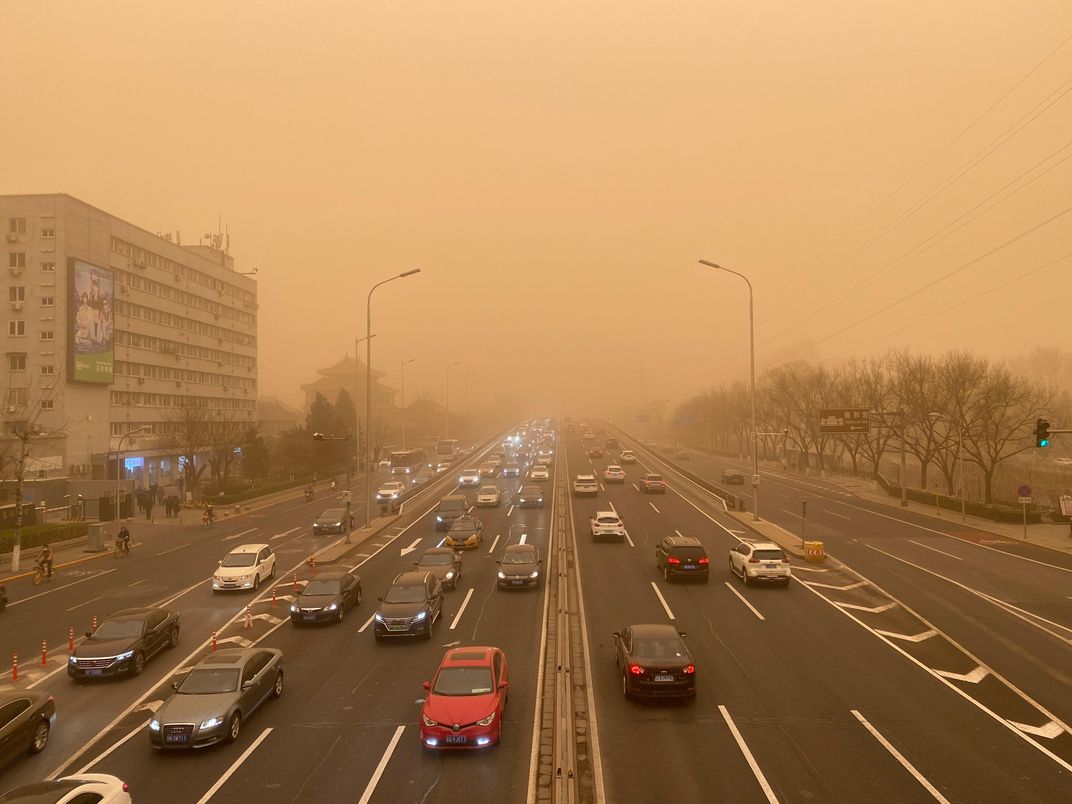Largest Dust Storm in More Than a Decade Blanketed China This Week
Air quality readings in Beijing reached dangerous levels while residents were urged to stay indoors
:focal(2413x1632:2414x1633)/https://tf-cmsv2-smithsonianmag-media.s3.amazonaws.com/filer/df/f6/dff6d3fe-4e23-40b0-a0a7-2c57282d5585/gettyimages-1307300740.jpg)
This week, millions of people in northern China suffered through the region’s largest and strongest dust storm in over a decade. On Monday morning, the country’s national meteorological center warned airborne sand and dust were expected to stretch from the northeast Heilongjiang Province to the northwest Xinjiang region. The ecological storm may have started after a brief snow surge in Mongolia picked up dust and comes after weeks of heavy air pollution in northern China.
The storm kept hundreds of scheduled air flights grounded and closed schools on Monday, reports Steven Lee Myers of the New York Times. Officials in the capital city of Beijing ordered children, the elderly and the sick to stay indoors and urged others to stop nonessential outdoor activities.
Per Echo Xie for the South China Morning Post, the China Meteorological Administration says visibility in Beijing on Monday had reduced to about 1 kilometer, or roughly .6 miles. The center recommended the public shut doors and windows and wear masks and scarves to protect from airborne pollution.
“I couldn’t see the building across the street,” says Wang Wei, a college graduate in Beijing, to the New York Times. “I didn’t think the sky could be this yellow.”

Air quality readings in Beijing were drastic. Helen Davidson of the Guardian writes the air quality index in the city hit a "hazardous" 999, contrasting other readings at the time in New York (26), Tokyo (42) and Hong Kong (a moderate 66).
The concentrations of harmful PM2.5 particles reached extremes as well. PM2.5 stands for “fine” particulate matter measuring 2.5 micrometers in diameter, which is small enough to penetrate human lungs and enter the bloodstream, according to WHO. This airborne matter is a mixture of solid and liquid particles containing substances such as sulfate, ammonia, sodium chloride and water. Frequent exposure to PM2.5 and “coarse” PM10, which is 10 micrometers wide and enters deep into the lungs, is tied to cardiovascular and respiratory diseases and lung cancer.
In Beijing, PM2.5 particle measurements surpassed 600 micrograms in parts of the city, hitting a 24-hour average of 200 micrograms before the afternoon, according to the Guardian. The average was well beyond the World Health Organization’s (WHO) recommendation of a daily PM2.5 concentration of 25 micrograms. Larger PM10 particles in Beijing also greatly exceeded WHO’s daily recommendation, per the South China Morning Post.
In the United States, the Environmental Protection Agency (EPA) regulates these particles, which at their largest are about 30 times smaller than a strand of human hair. The EPA says most particulate matter, or particle pollution, is created when pollutants produced from factories, cars and industries react to each other in the atmosphere. However, some matter is directly formed by sources such as fires or construction sites.
Sandstorms in China are common during this time of year, reports the Guardian, and they are usually connected to winds sweeping through the Gobi Desert to the north of China and south of Mongolia. Zhang Bihui, an official with the National Meteorological Center, says a whirlwind known as a “Mongolian cyclone”, combined with hot and dry conditions in Mongolia, may have caused this week’s storm.
“The sandstorm in Mongolia is severe,” Zhang told the South China Morning Post. “...With proper transmission conditions, it has resulted in the severe sandstorm in Beijing.”
/https://tf-cmsv2-smithsonianmag-media.s3.amazonaws.com/filer/32/e8/32e833f2-d0b7-45e0-b052-d064daf3000a/gettyimages-1307519972.jpg)
The New York Times reports Mongolia had a short but intense snowstorm known as a “snow squall,” which brought with it winds that picked up dust. At least nine people in the country died following the snowstorm and ensuing dust storm. Spring dust storms are also influenced by desertification.
To stop the pollutants from entering the capital, China has tried creating a “great green wall” of trees to block their movement and various other environmental efforts.
Last year, Chinese president Xi Jinping pledged to increase efforts lowering carbon emissions, and air quality in the country has improved over the last few years, per the New York Times. However, smog was present in China over the previous few weeks, and a new five-year development plan did not feature specific ideas on combatting climate change that environmental groups were looking for.
Li Shuo, Greenpeace China’s policy director, told the New York Times that industrial pollutants around the capital in 2021 had surpassed annual levels over the last four years.
“Beijing is what an ecological crisis looks like,” Li wrote on Twitter during Monday’s dust storm.